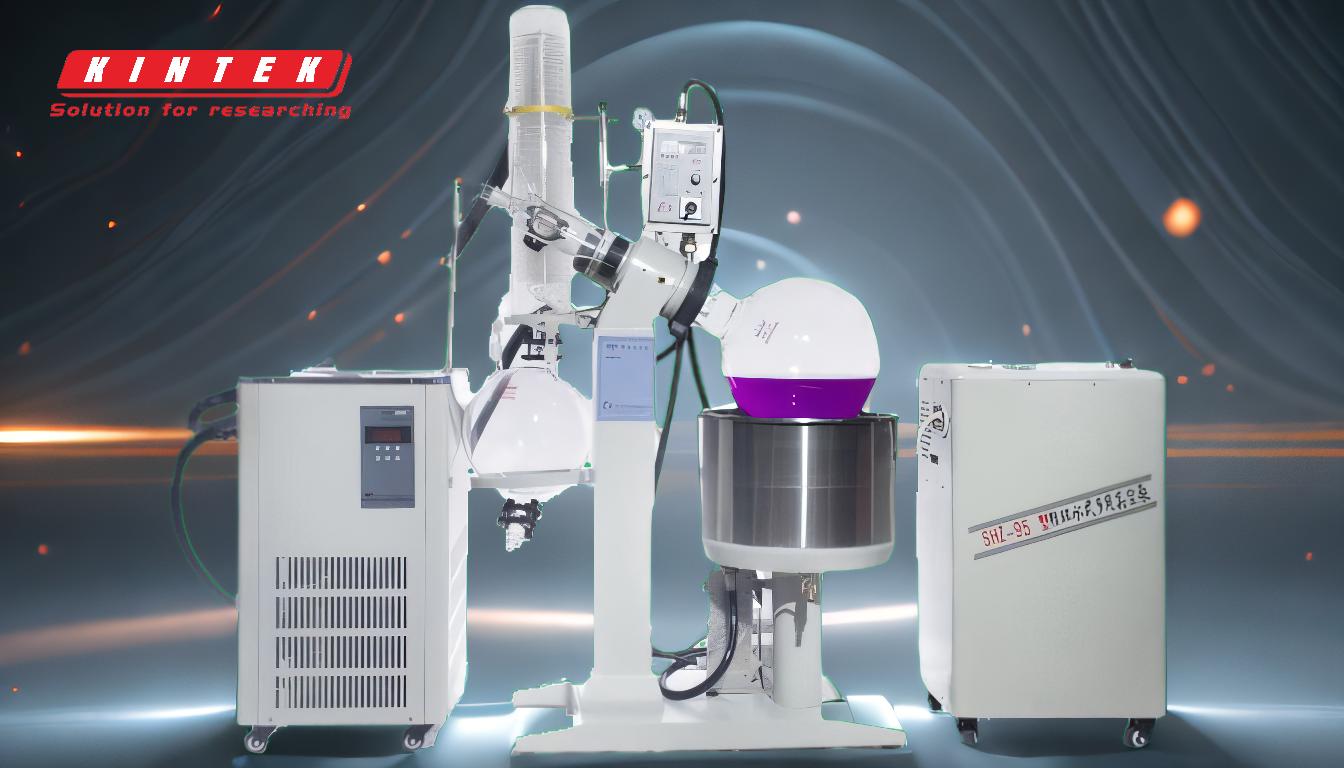A rotary evaporator (rotovap) removes solvent through a combination of reduced pressure, controlled heating, and condensation. The process begins by lowering the pressure inside the system, which reduces the boiling point of the solvent. The solvent is placed in a rotating flask, which increases its surface area and promotes even heating. A heated water bath further accelerates evaporation. The solvent vapors are then condensed using a chilled condenser and collected in a separate flask, leaving behind the concentrated compound. This method is efficient, precise, and minimizes the risk of thermal degradation.
Key Points Explained:

-
Reduction of Pressure to Lower Boiling Points
- The rotovap operates under vacuum conditions, which significantly lowers the boiling point of the solvent.
- When the pressure of a liquid decreases, its boiling point also decreases. This allows the solvent to evaporate at a much lower temperature than its standard boiling point, reducing the risk of damaging heat-sensitive compounds.
- This principle is central to the rotovap's efficiency and is particularly useful for solvents with high boiling points.
-
Rotation of the Evaporation Flask
- The solvent is placed in a round-bottomed flask that rotates at a controlled speed.
- Rotation creates a thin film of the solvent on the inner walls of the flask, increasing the surface area exposed to heat.
- This maximizes the rate of evaporation and ensures even heating, preventing localized overheating or uneven concentration of the solution.
-
Heated Water Bath for Controlled Heating
- The rotating flask is immersed in a heated water bath, which provides consistent and controlled heating to the solvent.
- The temperature of the water bath is carefully regulated to ensure the solvent evaporates efficiently without overheating the sample.
- This step is crucial for maintaining the integrity of heat-sensitive compounds and achieving precise solvent removal.
-
Condensation of Solvent Vapors
- The evaporated solvent vapors are directed into a condenser, which is typically cooled using a cold finger or chilled water.
- The condenser cools the vapors, causing them to re-condense into a liquid.
- The condensed solvent is collected in a separate receiving flask, where it can be reused or disposed of as needed.
-
Separation of Solvent and Compound
- As the solvent evaporates and is collected, the non-volatile compound remains in the original flask.
- This process effectively separates the solvent from the compound, leaving behind a concentrated or purified product.
- The rotovap is particularly useful for isolating compounds that are sensitive to heat or require precise solvent removal.
-
Factors Influencing Evaporation Rate
- The efficiency of solvent removal depends on several factors, including:
- Rotation Speed: Faster rotation increases the surface area of the solvent, speeding up evaporation.
- Bath Temperature: Higher temperatures accelerate evaporation but must be carefully controlled to avoid overheating.
- Vacuum Pressure: Lower pressure reduces the boiling point, enabling faster evaporation at lower temperatures.
- Condenser Temperature: A colder condenser ensures efficient condensation of solvent vapors.
- The efficiency of solvent removal depends on several factors, including:
-
Advantages of Rotovap over Traditional Distillation
- The rotovap is more precise and efficient than traditional distillation methods.
- It minimizes the risk of thermal degradation by operating at lower temperatures.
- The rotating flask ensures even heating and mixing, leading to more consistent results.
- It is particularly suited for handling heat-sensitive compounds and solvents with high boiling points.
By combining these principles and steps, a rotary evaporator effectively removes solvents while preserving the integrity of the desired compounds. This makes it an indispensable tool in laboratories for applications such as solvent recovery, compound purification, and concentration of solutions.
Summary Table:
| Key Feature | Function |
|---|---|
| Reduced Pressure | Lowers boiling point, enabling evaporation at lower temperatures. |
| Rotating Flask | Increases surface area for even heating and faster evaporation. |
| Heated Water Bath | Provides controlled heating to accelerate solvent evaporation. |
| Chilled Condenser | Condenses solvent vapors for collection in a separate flask. |
| Separation of Compounds | Leaves behind concentrated or purified compounds in the original flask. |
| Advantages Over Distillation | More precise, efficient, and minimizes thermal degradation. |
Discover how a rotary evaporator can enhance your lab's efficiency—contact us today for expert guidance!









